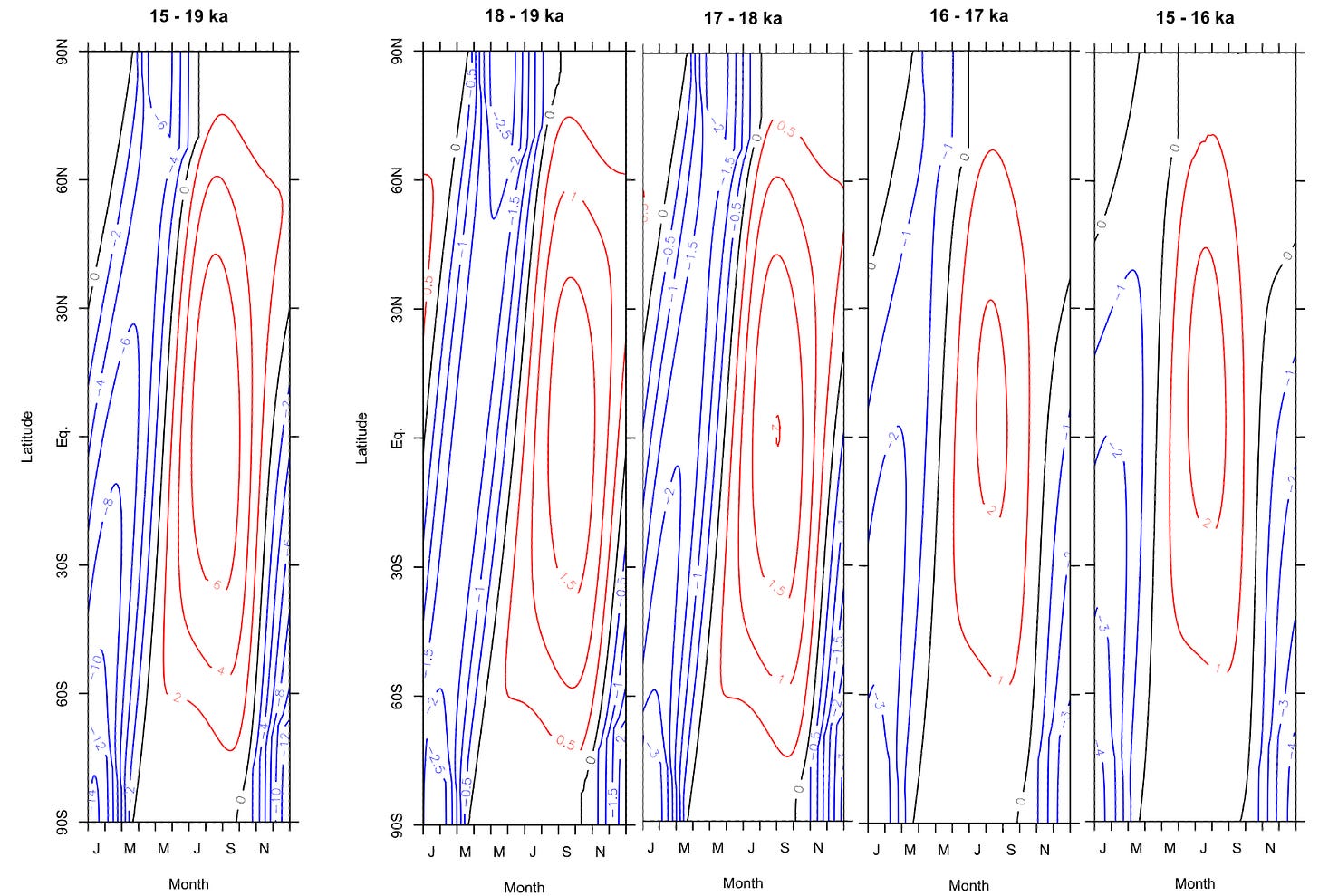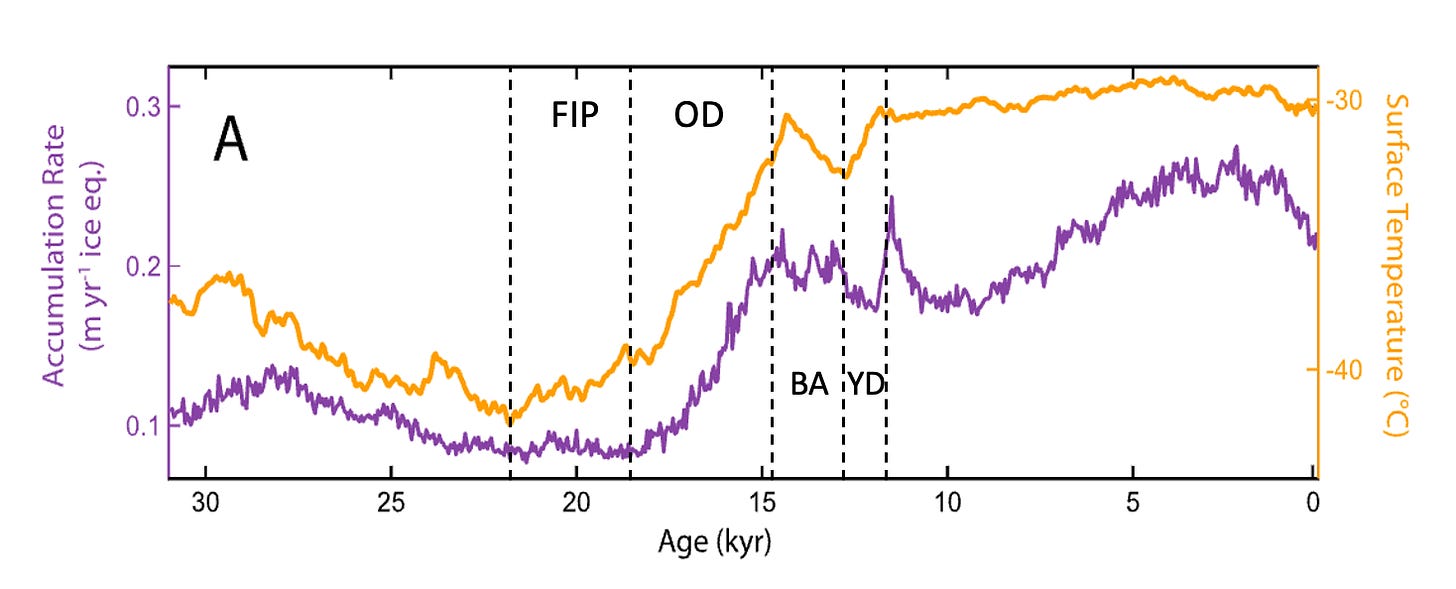20 - Strategic melting during the Oldest Dryas
Cracks in the ice appear when the heat is switched on
The previous post noted that the end of the Last Glacial Period (LGP) around ~19 ka postdated the Last Glacial Maximum (LGM) by about 7 millennia. This post revisits the Oldest Dryas (OD; 18.5 - 14.7 ka) period, and reinterprets the melting events in terms of the Integrated Geomagnetic-Geothermal-Surface Temperature (IGGT) model.
Jumpstarting the global thermohaline circulation current
One of the oddities surrounding the previous glacial to interglacial transition was the occurrence of what’s known as the “bipolar seesaw”, the phenomenon whereby temperature variations in the Northern (NH) and Southern Hemisphere (SH) were concurrent but out of phase to one another. For example, the Antarctic Cold Reversal (14.5 - 12.8 ka) was a period when vigorous glacial melting in the NH concurred with renewed glacial growth in the South Atlantic.
The global thermohaline circulation current (GTCC) “conveyor belt” is one of the largest re-distributors of heat and cold between the Northern (NH) and Southern (SH) Hemispheres, and is the obvious starting point when looking for causes of such disparities. Changes in the GTCC, including changes in direction and strength of the individual currents, are often proposed as the cause of of ice age climate fluctuations[4]. It’s worth noting that the GTCC’s fast (km/h) surface currents are primarily driven by wind shear, while its slower, deeper currents (km/year) are primarily driven by seawater density (salinity/temperature) differences as well as geothermal warming along their trajectories. The Atlantic Meridional Overturning Circulation (AMOC) and Southern Meridional Overturning Circulation (SMOC) near Antarctica form the Atlantic legs of the GTCC. The AMOC is the largest horizontal advector of hot and cold energy between the North and South Atlantic, and will be shown to have had a prime role in ending the LGP.

The previous post noted that sometime around 19 ka the circum-Antarctic sea ice cover retreated far enough to largely free the South Atlantic / Drake Passage, thereby jumpstarting the Antarctic Circumpolar Current, the AMOC/SMOC surface currents, and the GTCC, resulting a step-change in the NH - SH horizontally advected heat energy.
The First Interglacial Period 22-19 ka
Paleogeographic reconstructions indicate very little glacial melting - and even some growth - occurred between 22-19 ka in North America and Europe. Net solar insolation increases mainly occurred over tropical and subtropical areas during the SH fall, while large net solar insolation decreases occurred at higher latitudes during the NH and SH summer melting seasons. Any glacial melting during this period was therefore very likely due to basal glacier melting caused by increases in geothermal heat.

The jumpstart of the GTCC surface currents around 19 ka resulted in a warming AMOC through the horizontal advection of tropical and subtropical Indian and Southern Pacific ocean heat. This temperature increase in turn was very likely responsible for the small, mainly offshore Long Island, Nova Scotia and Labrador ice retreats around ~19 ka (below), though geothermal melting is also a possibility as this area is also underlain by a local geothermal anomaly.
A previous post documented that an elevated North American geothermal heat flux between 20 - 18.5 ka caused the “Couger Stage” (20.5 - 18 ka) Mount St. Helens (USA) active volcanism, and very likely created the dam and generated the first floodwaters of the Lake Missoula megafloods.

A little local melting and some growth occurred in Europe between the ice sheet’s maximum glacial extent (~27 ka) and ~19 ka: the Barents Sea froze over and the glaciers advanced to the East. This is consistent with paleoclimatic reconstructions that indicate cold temperatures dominated the tundra-covered European landscape until at least ~15.5 ka[4], that is almost until the Bølling-Allerød (14.9 -12.9 ka).

The Oldest Dryas - Solar Insolation and Climate

A quick look at the solar insolation changes during the OD shows that the high-latitude SH received progressively less solar insolation during its summer melting season throughout the entire OD. This strongly suggests that most vigorous glacier retreats in the SH were very likely due to severe increases in basal melting caused by increasing geothermal heat. Similarly, the high-latitude NH received progressively less summer solar insolation during the first half of the OD, although this trend appeared to reverse around ~17 ka.

Sea surface temperature (SST) proxies from sediment core studies[5,8] (graph above) indicate that the North Atlantic and Gulf of Mexico SST’s rose by 2-5 °C during the OD. This warming was very likely due to the strengthening and warming of the GTCC surface currents around ~19 ka, which renewed the horizontal advection of Indian and South Pacific ocean tropical heat energy to the Atlantic basin, and not due to local solar insolation variations.

North American and European paleogeographic reconstructions confirm their cold climates were not benefitting from either an increase in solar insolation or a significant regional temperature boost from weather systems gaining energy from the warmer GTCC surface currents . Both continents remained ice-locked during the OD, although the North American climate started progressively warming from around ~17 ka[4], possibly due to a warming AMOC and/or an increase in fall solar insolation. Europe’s cool climate flora was characterized by the relative abundant occurrence of Dryas octopetalys, an indicator species of arctic-alpine regions
The Oldest Dryas - Southern Hemisphere

Antarctic surface temperatures and accumulation rates increased steadily and in lockstep over the OD, very likely due to both a retreating circum-Antarctic sea ice cover, as well as a warming Antarctic Circumpolar Current.
The Patagonian Ice Sheet quickly melted due to a “stepped warming” between 17.5 - 17.15 ka[7], which almost certainly was not due to any increase in SH solar insolation. A previous post documented that a stepped increase in local geothermal heat along the Andes geothermal anomaly around 17.5 ka very likely caused an increase in basal melting, thereby triggering an increase in downstream advected meltwater energy, resulting in an increase in glacier velocity[7] and basal friction heat, and therefore an stepped increase in downstream glacier melting, in the reverse process to what was happening to the Ross glaciers in 2004. A future post will demonstrate this stepped heating - perhaps fortuitously - concurred with major Solar Particle Events (SPE’s) around 17.7 and 17.2 ka (“Miyake” events).
The Oldest Dryas - Northern Hemisphere

A previous post documented that elevated geothermal heat fluxes between 20-14.7 ka very likely caused the basal parts of the Cordilleran and Laurentide ice sheets to melt in Western Canada. The downstream flow of their meltwaters caused horizontal advection of meltwater heat to lower-lying glaciers, which in turn resulted in the downstream glaciers’ melt and retreat. A low albedo “interglacial” corridor in central Canada grew along the suture zone between the two ice sheets. Towards the latter periods, e.g. 14.9 ka, this glacial melting was increasingly aided by the increasing solar insolation energy absorption along the low albedo corridor. Due to the regional slope to the east (towards Hudson Bay) the meltwaters from the Laurentide ice sheet no longer drained to the south, so no longer re-filled Lake Missoula, but ponded along the eastern boundary of the corridor.
In the New York / Great Lakes areas the jumpstarted AMOC surface currents generated warmer east coast US weather systems that could intermittently melt the southeastern Laurentide ice sheet, although until ~17 ka the AMOC swurface currents were still too weak to prevent the re-advance of the ice sheets around 18.3 ka. After ~17 ka the Laurentide ice sheet retreated permanently to the north from its LGM extent in the New York / Southern Great Lakes area due to the general warming of North America, mainly due to the ever-warming AMOC surface currents, as well as the collapse of the katabatic wind systems over North America due to the growing interglacial corridor.[4]
Around 15.6 ka the retreat of the James and Des Moines Lobes in the Dakota / Iowa area very likely resulted in the meltwaters of the Western Canada and Great Lakes glaciers to drain via the Missouri/Mississippi into the Gulf of Mexico, causing a temporary cooling of the surface temperatures there (see graph above). Sometime around ~17 ka the St Lawrence Estuary began to lose its ice cover. The St Lawrence and Iro-Mohawk river meltwater paths together enabled the large influx of sweet, cold meltwaters directly into the North Atlantic basin.
The ~17-16 ka H1 “Heinrich Event”[8] resulted in the prolific deposition of ice-rafted debris across the North Atlantic. Its debris contains a large amount of detrital carbonates which very likely were derived from the Appalachian mountains between New York and Labrador. Heinrich events very likely occur when geothermal heat melts the basal layers of coastal glaciers, causing large-scale glacier calving and ice rafting. The New York - Nova Scotia Appalachians overly a regional geothermal anomaly, so a geothermal heat increase around ~17 ka very likely caused the H1 event. A future post will demonstrate this geothermal increase - perhaps fortuitously - concurred with a major SPE around 17.2 ka (“Miyake” event).

European paleogeographic reconstructions confirm its cold climate, characterized by the relative abundance of Dryas octopetalys, an indicator species of arctic-alpine regions. Solar insolation variations were almost certainly not responsible for the retreat of the Barents Sea ice cover, the British / North Sea ice sheets, the Alpine glaciers, or for the retreat of the European Ice Sheet to the Fennoscandian Shield. This melting occurred over geothermal anomalies (figure lower right): an increase geothermal heat fluxes between 19-15 ka very likely caused the basal parts of the European ice sheets overlying geothermal anomalies to melt. The downstream flow of the meltwaters caused horizontal advection of their meltwater heat, which in turn caused downstream glaciers to melt and retreat.
Summary
The 22-14.7 ka melting was predominately due to regional increases in geothermal heat flux caused by Orbital Inclination Forcing and incident Solar Particle Events. These increases first caused the retreat of the Antarctic sea ice cover between 22-19 ka, resulting in the jumpstarting of the global thermohaline circulation current, which in turn progressively warmed the Atlantic ocean via the Atlantic Meridional Overturning Circulation surface currents. The warmer AMOC in turn generated the warmer weather systems that caused the intermittent retreats of the Laurentide ice sheet in the New York and Southern Great Lakes areas. Increases in geothermal heat flux were similarly responsible for the western Canadian melting of the Laurentide and Cordilleran suture zone - and the Lake Missoula megafloods - as well as the H1 Heinrich event, the retreat of the European ice sheet to the Fennoscandian Shield, and the collapse of the Patagonoan Ice Sheet. After ~17 ka the melting was being progressively boosted by increases in solar insolation, the increasing temperatures of the AMOC surface currents, as well as the greater solar energy absorption of the newly ice-free, low albedo areas.
References
[1] Hodgson, D., et al., 2014, Terrestrial and submarine evidence for the extent and timing of the Last Glacial Maximum and the onset of deglaciation on the maritime-Antarctic and sub-Antarctic islands, Quaternary Science Reviews, 100, 137-158, https://doi.org/10.1016/j.quascirev.2013.12.001.
[2] Dyke, A., 2004, An outline of North American deglaciation with emphasis on central and northern Canada. Developments in Quaternary Sciences.,
[3] Hughes, A. et al., 2015, The last Eurasian ice sheets – a chronological database and time-slice reconstruction, DATED-1. Boreas, 45, 10.1111/bor.12142.
[4] Andersen, B., Borns, H., 1994, The Ice Age World, Oxford University Press. ISBN 978-8200218104
[5] Williams, C. et al., 2010, Deglacial abrupt climate change in the Atlantic Warm Pool: A Gulf of Mexico perspective, Paleoceanography, 25, PA4221, doi:10.1029/2010PA001928.
[6] Fudge, T. J., et al., 2016, Variable relationship between accumulation and temperature in West Antarctica for the past 31,000 years, Geophys. Res. Lett., 43, 3795–3803, doi:10.1002/2016GL068356.
[7] Hulton, N. et al., 2002, The Last Glacial Maximum and deglaciation in southern South America. Quaternary Science Reviews , 21, 233–241
[8] Hemming, S., 2004, Heinrich events: Massive late Pleistocene detritus layers of the North Atlantic and their global climate imprint. Reviews of Geophysics, 42, RG1005. doi:10.1029/2003RG000128.
[9] Obbink, E. et al., 2010, Eastern North American freshwater discharge during the Bolling-Allerod warm periods. Geology, 38, 171-174. 10.1130/G30389.1.





